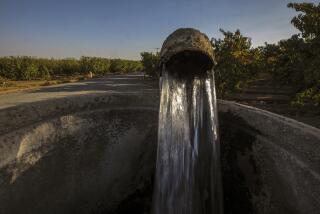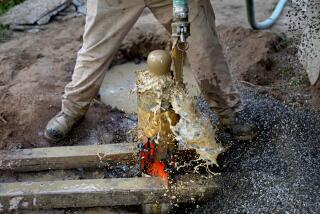Sure Cure for Water Worries--a Home Well
- Share via
SAN DIEGO — While his Escondido neighbors are fretting over 20% water cutbacks and penalties for overuse and wondering which parts of their landscaping to let turn brown, Don Marnella is smugly watering his pampered lawn and his stately, 40-year-old avocado trees to his heart’s content.
A few blocks away, Bruce Harwood is doing the same.
In Fallbrook, so is Robert Gonsett.
Angela and Perry Herst, building a new home in Rancho Santa Fe, want their lawn to look just as spectacular--complete with a decorative pond.
No fear of water cops for these folks. They’ve simply plumbed Mother Earth.
Hundreds of San Diego County residents, spurred into action by the drought and water cutbacks, are spending up to $15,000 to drill wells in their yards.
The county Department of Health Services, which must approve applications for water wells, received requests for 1,410 new wells during the 1990-91 fiscal year--up from 954 the previous year, and 382 the year before that.
“I’m sure all the publicity about the drought has had something to do about that,” said Horace Ketcham, who oversees the county’s application process.
Those who drill water wells say business has never been better, and those who can afford private wells say they enjoy knowing they’ll have green lawns, drought or no drought.
“My lawn will be green, my trees will stay alive and I’ve got peace of mind,” said Marnella, the third person on his block on Orange Avenue in Escondido to sink a well.
For well drillers, the drought has meant a boom. “As soon as the Metropolitan Water District (the water wholesaler for Southern California) talked about cutting water back by 50% earlier this year, my phone started ringing off the hook,” said Greg Kircher, co-owner of the Hugh M. Harris Drilling Co. in Escondido.
“By February, I had enough work lined up to last me through mid-June,” he said. “Normally, I’m only backlogged three weeks.”
Tim Hettich at Acme Drilling has bid on 212 well jobs this year, compared to 146 in all of 1989. “People want to make sure they’ve got plenty of water to keep their places green while everyone around them is letting their shrubbery turn brown,” he said. “We’re talking mostly about the well-to-do people in residential areas who can afford this.”
Most are for landscaping purposes, not to supply indoor lines or swimming pools, he said. Before water can be used in the house, its purity must be tested by county health officials.
Historically, most agricultural wells have been sunk on ranches and groves where water was needed for fruit trees and other crops, but more are being drilled in the front and back yards of homes in suburban settings, according to well-drilling companies.
Unless a water well is prohibited by subdivision rules, homeowners are free to sink wells on their property if they meet county regulations about distance from the house and sewer and property lines. The rules effectively limit wells to properties an acre or more in size.
Price can limit them too. Well, pump and other water lines might cost from $3,000 to $15,000 or more. Then there is the cost of the electricity to run the pump, bring the water to the surface and move it through sprinkler lines.
Once the drillers strike water, it belongs to the property owners, free and clear. “I remember one man asking me: ‘When I get the water, who do I pay for it?’ And I told him, you don’t pay anybody. It’s yours,” said Ketcham. “He was very happy to hear that.”
Los Angeles and Orange counties are not seeing a similar wellspring of interest.
Much of Los Angeles is over subterranean water basins, but taking water from them requires a court order and reimbursing the Metropolitan Water District. The cumbersome legal maneuvers and high cost discourage most people from trying, one regional water official said.
Jack Petralia, director of environmental protection for the Los Angeles County Department of Health Services, said that during 1990-91, 230 permits were issued for wells, down from 330 the previous year. He said that most homeowners who explore the idea find that it is not cost effective.
Larry Honeybourne, who oversees water well permits in the Orange County Health Department, said fewer than two dozen well permit requests have crossed his desk this year.
That is in part because southern Orange County’s water quality is poor, even for agricultural purposes, and most county residents are served by water basins in central and northern Orange County, whose water is cheaper than the MWD’s.
“Already, the water prices are relatively inexpensive, so it wouldn’t be financially beneficial to sink your own well,” Honeybourne said.
While water is not hard to find beneath San Diego County, there is no guarantee that the drillers will strike it. Some companies rely on hydrogeologists to help find a likely site; others use “water witchers” armed with divining rods.
“I don’t underexaggerate the possibility of a dry hole,” said Kircher. “There are no guarantees in this business. If it’s a dry hole, I offer a reduced bill. But on the average, 80% of the wells we sink in North County are wet.”
“It was a gamble I was willing to take,” said Harwood, who lives on an acre lot in an upscale subdivision in Escondido and who spent about $20,000 for his well.
“I’ve lived here for five years and I started thinking about sinking a well during all the initial talk of the drought last year,” Harwood said. “There was no way I could cut back to even 20% without losing some of my landscaping, so I started considering my options.”
“If I had known about the drought originally,” Harwood said, “we wouldn’t have landscaped the way we did to begin with. But now I can relax. I don’t have to worry about the 20% cutbacks or about water rate increases. And it’ll be that much easier for me to sell my house.”
Out in Rancho Santa Fe, the Hersts are building a new, Mediterranean-style home on a four-acre lot with a 2 1/2-acre orange grove. They have planned drought-resistant landscaping and a decorative pond that will serve as a basin to store well water for irrigation.
“We could get by on the city water,” said Angela Herst. “But there’s a difference between ‘getting by’ and peace of mind. . . . If you have a love of land, and of plants and trees, it’s terribly disturbing to have to watch it die because there’s not enough water.”
More to Read
Sign up for Essential California
The most important California stories and recommendations in your inbox every morning.
You may occasionally receive promotional content from the Los Angeles Times.













